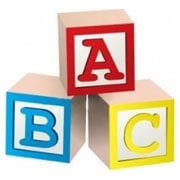Every parent knows the tremendous value of a good toy, but often overlooked are the educational toys benefits. “Play is an essential component of healthy child development,” says Cindy Haines, MD, Chief Medical Officer of HealthDay News. “Play not only contributes to a child’s cognitive, physical, social, and emotional well-being, it also offers numerous opportunities for parents and children to more fully engage with each other.” In the earliest ages, almost any type of play is educational. Peek-A-Boo and Pat-A-Cake teach socialization and interaction skills to infants. Most pre-schools today teach children to learn through play.
“It is interesting to note, in an age of ever-advancing technology, some of the best toys are the most simple,” says Dr. Haines. “A 2007 report from the American Academy of Pediatrics emphasized the benefits of more basic toys (such as blocks and dolls) in which children more fully utilize their powers of imagination versus more passive toys that limit user engagement.” This has tremendous educational benefits. For example, a child with 10 blocks may build a tower. That child has learned problem solving (how to stack them), increased hand-eye coordination, and even learned basic physics (everything falls when they knock it over).
As a child grows, the educational component of general play diminishes, but toys do not lose their educational value. There are thousands of toys that are marketed as primarily educational toys. Many readers may think immediately of math games, spelling games, kid computers and puzzles as examples of educational toys. There are thousands more where the educational component is a secondary benefit to something that may appear to be merely for play.
I know of a family who used Connect Four as an indirect way to teach cognitive problem solving. The family’s fourth grade daughter had above average Iowa standardized test scores in most areas. However, the daughter’s cognitive problem solving scores were well below average. After losing several games of Connect Four in a row, she learned to take defensive action when she saw an offensive pattern developing. Later, she learned to plan ahead for offensive action of her own. She was learning while playing.
My company, FireHydrant Creative Studios, works with people who create fun products that also have educational benefits, one recent creation being Skippy Dimpledot, a toy in which children write letters to their elf and the elf “magically” writes back. We liked that Skippy Dimpledot was more than a way to control behavior, but instead was an interactive play toy. However, what really caught our attention was the letter-writing aspect of the tradition. Considering the age of the child we are marketing to, we thought there was a tremendous secondary educational benefit to this toy. Even children who cannot write full letters can learn to write their name, or even one letter of the alphabet. The longer the child plays with Skippy Dimpledot, the more the child learns about handwriting.
Toys should not be considered a tool merely limited for play. We encourage the readers of this blog to look for the direct and indirect educational benefits of toys when making purchasing decisions. Is there any better way for parents to help educate their children than through play?

Michael Margraf is the president and CEO of Firehydrant Creative Studios.

Cindy Haines, MD, is the author of the upcoming book “The New Prescription: How to Get the Best Health Care in a Broken System”.

